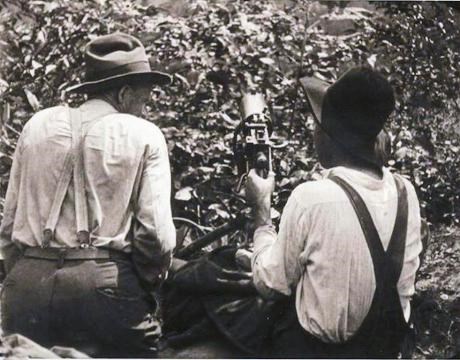Part of a series of articles titled West Virginia Mine Wars.
Previous: Sheriff Don Chafin
Article

Wikimedia Commons
The West Virginia mine wars culminated in a massive march of union miners through the coal towns of the southern counties. The participants ultimately sought to free miners in Mingo County who had been arrested and were being held in jail on charges of violating the martial law that the governor had imposed on the county. To get to Mingo, they first had to cross through Logan County.
In late August 1921, the union miners encamped in the town of Blair, just below Blair Mountain in Logan County. Blair Mountain forms a long ridgeline that the miners had to cross in order to reach Mingo County. Their first order of business was to deal with Don Chafin, the notorious sheriff of Logan County whose main job was to protect the coal mine operators’ interests. By the time the armed marchers arrived in Blair, Chafin had assembled his own army of civilian recruits that were protecting positions along the Blair Mountain ridgeline. It was on Blair Mountain where the two forces came face-to-face.
On the night of August 30, John Wilburn, a minister and part-time miner, led a group of 70 miners—including two of his sons—up the mountain. During a dawn patrol, Wilburn and four other men encountered three of Chafin’s deputy sheriffs including John Gore, an infamous mine guard in Logan County. In the gun battle that ensued, the miners shot and wounded Gore who then shot and killed miner Eli Kemp. Wilburn responded by shooting Gore in the head, ensuring that he was dead. This marked the beginning of the Battle of Blair Mountain. For the next three days, the two sides battled with gatling guns, rifles, and other firearms along the ridge of Blair Mountain. During the second day of fighting, Chafin ordered his men to fly airplanes over the encamped marchers and drop two nausea-inducing gas bombs, and two bombs filled with gunpowder, nuts and bolts. As historian James Green describes it in The Devil is Here in These Hills: West Virginia’s Coal Miners and Their Battle for Freedom, “Something extraordinary happened on Spruce Fork Ridge that day: American citizens were being subjected to aerial bombardment on their own soil.”

Wikimedia Commons
After several days of heavy fighting along the mountain ridge, the miners were ready to move into Logan County when the federal government stepped in, dispatching troops, planes, and munitions to the area. This intervention effectively ended the miners’ march before they could enter into full battle with Chafin’s army. The miners willingly surrendered to the federal troops because they were not rebelling against the federal government, but rather against the local and state governments that catered to mining interests to the extent of denying citizens their constitutional rights. In fact, miners viewed the intervention of the military as a victory, seeing it as a signal that the rule of law would return to the region, even though they did not succeed in freeing the jailed miners in Mingo or ridding Logan County of its corrupt sheriff. The fighting of the West Virginia mine wars officially ended on September 4, 1921. Due to the size, length, and violence involved, the legacy of this short battle has loomed large in American labor history, and continues to be a symbol of workers’ struggles in the past—many of which continue to resonate today.
The Blair Mountain Battle site is listed on the National Register of Historic Places (NHRP). The NRHP is the official list of the nation's historic places worthy of preservation. Authorized by the National Historic Preservation Act of 1966, the National Register of Historic Places is part of a national program to coordinate and support public and private efforts to identify, evaluate, and protect America's historic and archeological resources.
Discover more resources on the West Virginia Mine Wars and related topics here: Resources on the West Virginia Mine Wars.
Part of a series of articles titled West Virginia Mine Wars.
Previous: Sheriff Don Chafin
Last updated: September 27, 2024